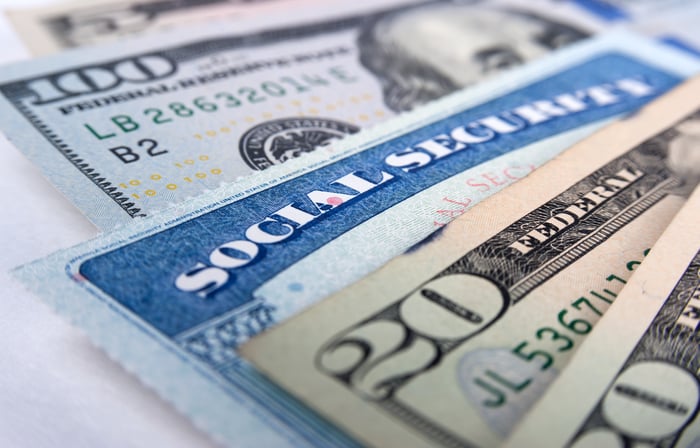An up-to-50% monthly payout reduction may be a reality for more than 1,000,000 Social Security recipients.
For most retirees, their Social Security income is indispensable. When surveyed by national pollster Gallup in April, 86% of retirees said that their monthly check is a “major” or “minor” income source. In other words, it’s a necessity, to some varied degree, to make ends meet.
However, this all-important retirement program isn’t on the best financial footing. Based on the latest Social Security Board of Trustees Report, the program is staring down a $25.1 trillion long-term (75-year) funding deficit, as well as the prospect of sweeping benefit cuts coming into play just eight years from now. If nothing is done, retired workers and survivor beneficiaries can see their monthly payouts slashed by up to 23% in 2033.

President Donald Trump. Image source: Official White House photo by Joyce N. Boghosian.
President Trump has overseen a flurry of Social Security changes since taking office
Although politicians often shy away from tackling issues with Social Security since it can cost them votes in upcoming elections, President Donald Trump’s administration hasn’t veered away from making big changes to America’s top retirement program.
Since beginning his second (nonconsecutive) term, Trump signed an executive order eliminating paper checks by Sept. 30, 2025. All federal distributions will need to be digitized (e.g., through direct deposit) in order to save costs, as well as reduce the possibility of fraud.
And the president has overseen the revamp of personal identification methods via the Social Security Administration (SSA). For example, changing your direct deposit information (with few exceptions) will require an in-person visit to the SSA or two-factor authentication via a “my Social Security” account.
Furthermore, Trump is responsible for the creation of the Department of Government Efficiency (DOGE), which preempted the SSA to announce a reduction of 7,000 employees and the shuttering of some of its offices. These actions fit with the Trump administration’s theme of reining in federal costs and making Capitol Hill more efficient.
But this isn’t all. Making Washington, D.C., more efficient includes Social Security’s trust funds, and not just the program’s administrative expenses. America’s leading retirement program is owed tens of billions of dollars — and the Trump administration aims to collect.
The question is: Are you one of the more than 1 million beneficiaries who could see their Social Security benefit garnished by the SSA?

Image source: Getty Images.
The Trump administration has placed a bull’s-eye on Social Security overpayments
If there’s such a thing as a clear target for the SSA and Trump administration, it’s collecting the $23 billion in Social Security overpayments that were outstanding at the end of fiscal 2023 (Sept. 30, 2023). According to data from health policy researcher KFF and Cox Media Group, nearly 2 million beneficiaries had been overpaid.
Sometimes these overpayments are entirely the SSA’s fault. Other times, responsibility lies with beneficiaries not updating their income information with the SSA, thereby resulting in an overpayment.
Prior to the pandemic, the clawback rate on Social Security overpayments stood at 100%. This means President Trump’s first term featured a 100% garnishment rate for Social Security checks until an overpayment was fully recouped.
However, this garnishment rate was lowered to just 10% per benefit check during Joe Biden’s presidency (which coincided with the pandemic). Although the SSA announced plans to reinstate the 100% clawback rate in March, public backlash caused the agency to rethink this strategy and amend its garnishment rate to 50% in April. With the SSA beginning to send out 90-day notices on April 25, overpayment garnishments for potentially more than 1 million beneficiaries began on July 24.
If there’s a silver lining for these folks, it’s that legal options do exist that can potentially waive or reduce what they owe the SSA:
- SSA-632BK (“Request for Waiver of Overpayment Recovery”): The best outcome would be to have your overpayment from the SSA completely waived. Filing Form SSA-632BK makes sense if the overpayment you received wasn’t your fault and you can provide documentation that paying back the extra benefits would cause a financial hardship.
- SSA-561 (“Request for Reconsideration”): Going this route makes sense if you can provide evidence that you weren’t overpaid and want your liability waived. Form SSA-561 is also an option if you agree that you’ve been overpaid but are contesting how much in extra benefits you received.
- SSA-634 (“Request for Change in Overpayment Recovery Rate”): Filing Form SSA-634 is the way to go if you admit to being overpaid, but can demonstrate a financial hardship to the SSA with qualified expenses. In other words, you’re still going to have to repay the extra benefits you’ve received, but this route may allow you to work out an extended payment plan that lowers the garnishment rate from 50% to a more palatable percentage.
With the Biden-era recovery rate a thing of the past, more beneficiaries can expect a significant haircut to their monthly check if they don’t opt for one of these three perfectly legal options to potentially waive or reduce what they owe.
Source link

